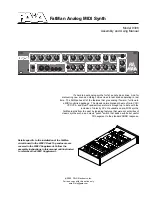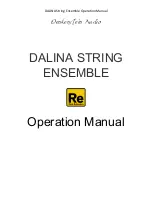
Genesis and Design Notes
6
Basimilus Iteritas started out as something very different than where it ended. I had been reading
Stefan Bilbao’s
Numerical Sound Synthesis
and was thinking about building a drum simulator out of a
set of numerical oscillators. I looked at spectrograms of many kick drums and settled on a one
oscillator per drum mode possibly adding interesting cross-mode interactions.
A few hours into a soware prototype convinced me this was not going to be a simple program.
Numerical oscillator implementation has a number of practical problems and pitfalls that I was
falling deeply into. Taking this difficulty as an oppurtunity to re ect, I asked myself, “What would
analog do?” I answered “construct a similar sound out of multiple easy to implement elements” is
led me directly to a simple wavetable additive architecture with exponential envelopes and noise.
Each oscillator is an analog of one mode of a drum. ere is a touch of irony as the analog
oscillators used in actual analog kicks are actually more closely related to the numerical methods
than the additive wavetable architecture that was nally settled on. is new architecture was very
suited to parameterization from musical terms rather than the terms that numerical models demand.
Even such basic things as pitch can be somewhat tricky with the methods in Bilbao.
e hardware development for Basimilus Iteritas went very smoothly. Only three PCB revisions exist
and the last two were almost identical apart from some minor changes to the ADC overvoltage
protection.
e CPU daughter-board was developed to be used in a wide range of future modules. It uses the
XMOS XS1 processor which is a great blend of exible, powerful and affordable. Basimilus Iteritas
was written in XC and C using the XMOS IDE. e algorithm was prototyped in C# and C as a
windows application to quickly iterate on the parametrization.
e internal signal chain is 8.24 xed point which is quantized to 16-bit for the DAC (TI 8411).
Basimilus Iteritas uses a dynamically adjustable sample rate to help move alias power to be at
frequencies related to the fundamental pitch of the drum and therefore be more musical. e
oscillators are essentially wavetable though they are evaluated on the y as this is needed for the
MORPH knob. ey have a period of 65536 samples but are decimated by a different amount
depending on the octave of the pitch. e noise generator is a simple linear congruential generator
decimated by octave similar to the waveform oscillators. e METAL setting is classic 80’s “who
cares about aliasing?” frequency modulation in all of its noisy glory.
Analog drums sound awesome in folders so a folder was an obvious add. Once advantage of digital
folding over analog is that additional sections are essentially free. Basimilus Iteritas adds as many
fold sections as will still continue to fold to maximize the amount of produced harmonics. It as well
cleanly compensates for the volume changes that occur during folding. e nal touch was to re-
apply the overall envelope to the signal aer the folder which gave back a lot of the dynamics that
are lost when folding to produce a kick that still has some percussive umph aer being massively
folded.
Noise Engineering
Basimilus Iteritas Alter
Analog-inspired parameterized drum synthesizer


















